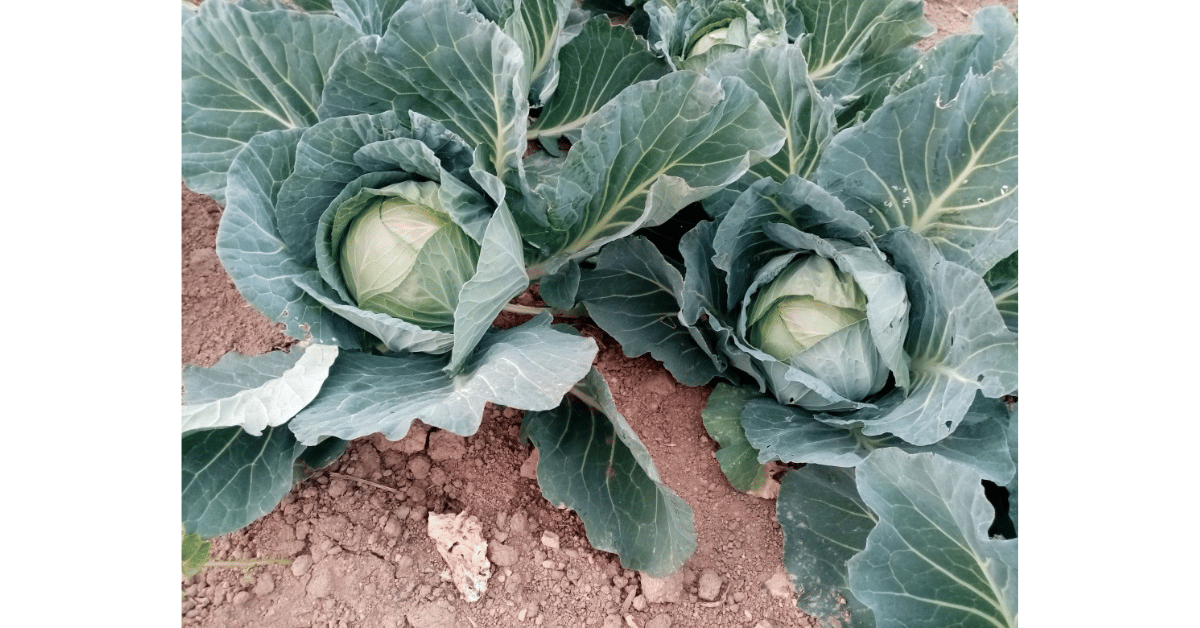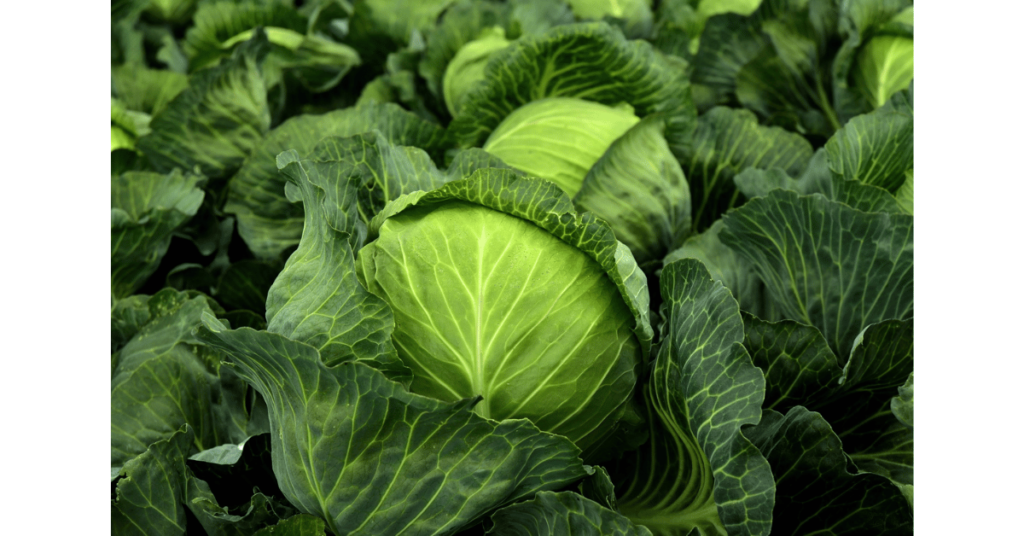What Are The Benefits of Cabbage

Cabbage is a versatile vegetable. It is a staple in many cultures.
Even my garden is full of them and ready for the plate.
It’s the base for tasty dishes like coleslaw and sauerkraut. But, its uses go beyond these well-known favourites.
This blog post explores the benefits of cabbage.
Join us as we shred the misconceptions. We will explore the tasty and healthy world of cabbage!
Beyond Coleslaw: Unveiling the Unexpected Benefits of Cabbage

Cabbage.
The name might conjure up images of bland coleslaw or boring boiled dinners.
But what if this humble veggie held the key to a healthier, more flavourful future for your meals?
Surprise!
Discover the nutritional powerhouse that cabbage is.
Cabbage packs a punch with vitamins and minerals. It boasts a range of health benefits. It deserves a starring role on your plate.
Get ready for a surprise.
Your cabbage’s nutritional facts.
Cabbage Nutrition Facts: A Low-Calorie Powerhouse
Cabbage might not be the flashiest vegetable, but remember its nutritional content!
Have you noticed some people sneer at you when buying cabbage in the fruit markets?
Don’t worry
Here’s why this leafy green (or red or purple) deserves a spot on your plate:
Low in Calories and Fat
One cup of chopped cabbage provides 22 calories.
It is a must-have choice for weight management or healthy eating.
It’s virtually fat-free, keeping your meals light and guilt-free.
Packed with Fibre
Cabbage has over 2 grams of fibre per cup. It is a good source of fibre, essential for digestive health. Fibre promotes regularity and keeps you full for longer.
Vitamin and Mineral Powerhouse
Cabbage is a surprising source of essential vitamins and minerals.
It’s particularly rich in Vitamin C, an essential immune function and health nutrient. It also has Vitamin K.
It is essential for clotting and bone health. It has Potassium, too.
It helps regulate blood pressure.
Additional Nutrients
The benefits listed above are some of the highlights. Cabbage also offers other vitamins and minerals in smaller amounts. They contribute to your well-being.
But wait
What are the different types of this superfood?
A World of Cabbage: Exploring Different Varieties
Cabbage is part of the cruciferous vegetable family. It has more than just its familiar green head.
Across the globe, wide cabbage varieties offer exciting flavours, textures, and culinary uses. Let’s delve into some of the most popular types:
Green Cabbage
Green cabbage is the primary type. Its tight, round heads and crisp leaves are well-known.
Its intense, slightly peppery flavour mellows when cooking. Perfect for coleslaw, sauerkraut, and braising.
Red Cabbage

Red cabbage is like green cabbage in texture and structure. But, it has a vibrant purple hue due to its anthocyanin.
It is a bit sweeter and milder than green cabbage. It is excellent in salads or roasted for a colourful side dish.
Savoy Cabbage

It is easy to identify by its crinkled, loose leaves. Savoy cabbage has a milder flavour and a softer texture than green cabbage.
It is excellent for salads, slaws, or braising, where its leaves can wilt beautifully.
Napa Cabbage (Chinese Cabbage)
Napa cabbage is a staple in Asian dishes. It is elongated, cylindrical, and has pale green leaves.
It has a tender, crisp texture and a slightly sweet flavour. Perfect for stir-fries and kimchi and added to soups or stews.
Bok Choy (Baby Pak Choi)
Bok Choy is a smaller relative of Napa cabbage. Its dark green leafy tops are crisp white stalks.
It has a more robust flavour than Napa cabbage and cooks quickly, making it ideal for stir-fries or soups.
These are just a few of the many cabbage varieties you can explore.
Here are some more exciting options:
Brussels Sprouts
These miniature green “cabbages” grow on a long stalk and offer a complex, nutty flavour. Enjoy them roasted, steamed, or shredded in salads.
Kohlrabi
This unusual vegetable has a bulbous, turnip-like form with edible green leaves.
You can enjoy raw, roasted, or mashed bulbs and leaves because they have a mild, cabbage-like flavour.
Tuscan Cabbage (Cavalo Nero)
This heirloom variety has dark green, kale-like leaves with a strong, slightly bitter flavour. It holds its shape well during cooking and is delicious in soups, stews, and pasta dishes.
Cabbage varieties have different flavours and textures.
They have diverse uses in cooking. They offer home cooks a world of options.
Next time you’re at the market, be adventurous. Explore the exciting world beyond the familiar green cabbage head!
What are the health benefits of cabbage
The Health Benefits of Cabbage and Related Research
Cabbage goes beyond being a delicious and versatile ingredient.
Research suggests it has many health benefits.
Let’s delve into some of the key benefits and the research that supports them:
Improved Digestion
Cabbage is a good source of fibre, and it plays a critical role in promoting gut health and regularity.
Studies have shown that enough fibre prevents constipation and facilitates a healthy digestive system.
Cabbage and Heart Health
Cabbage has plant compounds like glucosinolates. They become sulforaphane in the body.
Studies have proven that sulforaphane fights inflammation. It may help lower cholesterol.
This low cholesterol could reduce the risk of heart disease.
Is Cabbage Good for Cancer
Cabbage and other cruciferous vegetables boast of glucosinolates. Some research suggests these compounds may fight cancer.
Studies show a link between eating more cruciferous vegetables and maintaining a low risk of some cancers.
These include stomach and colorectal cancer.
However, researchers must conduct more studies to understand these potential benefits fully.
Immune System Support
Cabbage is a vital source of Vitamin C. Vitamin C is a well-known antioxidant that the immune system needs.
Vitamin C gives the body the power to fight infection and facilitates the production of white blood cells.
Cabbage for Weight Loss
Low in Calories and Fat
A cup of chopped cabbage has only 22 calories, making it perfect for weight management. Its fat-free profile keeps meals light and guilt-free.
Cabbage is a Powerhouse
Cabbage boasts over 2 grams of fibre per cup.
Fibre keeps you full for longer. It promotes satiety and may cut calorie intake.
This control of satiety can help manage weight loss by curbing cravings and overeating.
Research on Fibre and Weight Loss
Studies suggest a correlation between increased dietary fibre intake and successful weight management.
A review in the journal Nutrients found that people who ate more fibre weighed less and were at a lower risk of obesity.
Disclaimer: It’s important to note that cabbage alone won’t guarantee weight loss.
However, incorporating it into a balanced, calorie-controlled diet can be a helpful strategy.
Cabbage for Diabetes
Low Glycemic Index
Cabbage has a low glycemic index (GI), meaning it causes minimal spikes in blood sugar levels. People with diabetic conditions must manage their blood sugar carefully.
Fibre for Blood Sugar Control
The fibre in cabbage can also help regulate blood sugar.
It does this by slowing the absorption of carbohydrates in the gut.
This low absorption can help prevent blood sugar spikes after meals.
Research on Cabbage and Diabetes
Researchers need more information to understand cabbage’s impact on diabetes. But, some studies show it has benefits.
The journal “Nutrition Research” published these benefits.
It found that drinking cabbage juice helps control blood sugar.
By eating cabbage, you can enjoy its delicious flavour. You might also get weight loss and diabetes benefits.
Remember, a healthy lifestyle still requires balanced meals and regular exercise.
Research is Ongoing
The research on cabbage’s health benefits is promising. But, most studies are observational. They cannot definitively prove cause and effect.
We need to do more research.
We also need to understand the mechanisms behind these potential benefits.
Additional Considerations
Some studies suggest that fermenting cabbage, as in sauerkraut and kimchi, may boost its health benefits.
This fermentation happens by increasing probiotics. These can further improve gut health [5].
Adding cabbage to your diet lets you enjoy its great flavour. It may also have many health benefits.
Can you benefit from a delicious cabbage meal?
Unleash the Cabbage: Delicious Ways to Add it to Your Diet.
Cabbage might seem like a humble ingredient, but its versatility knows no bounds!
You can add cabbage to almost any meal. You can eat it raw or cooked, fermented or fresh.
Here are some ideas to inspire your cooking creativity.
Salads
Shredded cabbage adds a delightful crunch to salads.
Try using a colourful mix of green and red cabbage for a vibrant touch.
Pair it with vegetables, fruits, nuts, and a light vinaigrette for a refreshing, healthy side dish.
Stir-Fries
Thinly sliced cabbage cooks quickly and adds a satisfying texture to stir-fries.
Add your favourite protein, vegetables, and sauce. This combination will make a quick and tasty weeknight meal.
Soups and Stews
Don’t underestimate the power of cabbage in soups and stews!
It adds a touch of sweetness and heartiness to these comforting dishes.
Napa cabbage works particularly well as it holds its shape well during cooking.
Sauerkraut and Kimchi
Options like sauerkraut and kimchi are full of probiotics. They are tasty and good for your gut.
Enjoy them as a condiment on hot dogs and burgers. Or, add them to stir-fries or rice dishes for a tangy flavour burst.
Cabbage Wraps
Ditch the tortillas and use large cabbage leaves instead!
Fill them with your best ground meat, veggies, and sauce. It’s a healthy and creative low-carb wrap option.
Coleslaw
This classic cabbage salad comes in endless variations.
Try different dressings. Add apples or carrots for sweetness. Also, add nuts and seeds for crunch.
Roasted Cabbage
Looking for a simple yet flavorful side dish?
Roasting gives the natural sweetness of cabbage.
Cut the squash into wedges. Toss them with olive oil and spices. Roast them until tender and slightly caramelized.
Stuffed Cabbage
This hearty dish has cabbage leaves stuffed with a tasty mix of rice, meat, and vegetables. It’s a delicious and comforting meal, perfect for a cold winter night.
Cabbage Pancakes
Finely shredded cabbage forms the base for these light and crispy pancakes.
Add your favourite spices and herbs, then pan-fry until golden brown.
These are just a few ideas to get you started.
Cabbage is a true kitchen workhorse with its affordability, versatility, and nutritional benefits.
A word of advice
Take notice of this healthy and tasty vegetable next time at the grocery store!
Conclusion
Be aware of cabbage as a nutritional powerhouse.
You’ve seen the benefits of cabbage.
Now it’s your turn.
Don’t let cabbage intimidate you!
Cabbage comes in many colours, textures, and flavours. There’s a type for every dish.
So be creative in your cooking. Start adding this great vegetable to your meals.
Browse the recipe ideas above. Explore various cabbages at your local market.
Discover the tasty and healthy world of cabbage!
